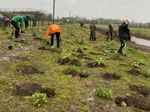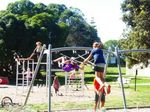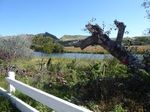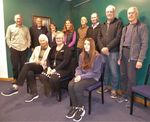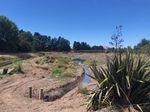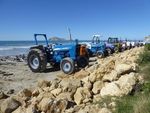WINGS AND WILDLIFE - Biodiversity ...
←
→
Page content transcription
If your browser does not render page correctly, please read the page content below
WINGS AND WILDLIFE
Community Newsletter
July 2021
Easter Sunday was when I and a lot of other people decided that
Waimarama was the place to be. It was a beautiful warm, sunny day
and there was a real holiday atmosphere with lots of surfers,
swimmers, boaties, fishermen (and women), sun-worshippers, families
and picnickers all enjoying the perfect weather. No wonder
Waimarama is a playground for the well-heeled. It is stunning - and for
permanent residents and visitors alike, it is blessed with a long, golden
sand beach and no fewer than seven public reserves.
At just over 11 hectares and split into three distinct areas, Waimarama Domain (also known as Airini
Donnelly Reserve) is by far the largest. In 2011, Hastings District Council and the Hawke’s Bay
Regional Council bought six hectares of
previously leased land from the Society of
Mary for $1.17 million. The timely
purchase means that all of Waimarama
Domain is now in public ownership.
There is a very popular playground with a
good variety of play equipment including
climbing frames and a flying fox.
Waimarama Surf Life Saving Club (Inc) plays a vital
role in keeping swimmers safe during the long, hot
Hawke’s Bay summers. Volunteers patrol the beach
10 a.m. to 5 p.m. on weekends from November
through to March while paid Regional Life Guards
fill in the weekdays during the peak Christmas
period to the end of January. The club’s striking
Paris Magdalinos cantilevered clubroom won the
2017 Hawke’s Bay/Gisborne Architecture Award.
Spoilt for choice, I went for a stroll along
the beachfront Harper Road Esplanade
Reserve at the southern end of the beach.
This long stretch of prime real estate
offers superb views out to Bare Island
(Motu-o-kura). It is coastal living at its best
and, being totally flat, is an easy walk with
access to the beach at regular intervals.
Situated close to the boat ramp, I loved seeing all the brightly coloured Ford and Ferguson tractors
lined up ready for duty. Some of the trusty, older model Fergies looked to date back to the 1950’s.
Heading back to the other end of the
township, I came across another
picturesque reserve and wetlands, where
there was an abundance of wildlife. It is
peaceful and just gorgeous. For details
of the other reserves, which I didn’t have
time to visit, head to the council
website:- www.hastingsdc.govt.nzHAVELOCK NORTH STREAMS COMMUNITY GROUP
You are invited to check out this recently formed Facebook page:-
https://www.facebook.com/groups/570134233966591/about
On 26 May, Nathan Burkepile, NZ Landcare Trust’s Regional
Coordinator for Hawke’s Bay convened the inaugural meeting of the
group, made up of interested people from the Karituwhenua Stream
Landcare Group (Bob Harris, David Belcher, Keith Passey), Tauroa
Reserve Care Group (Michelle Hicks and Jason Andrews), Friends of
Tainui Reserve (Jessica Maxwell), Te Mata Park Trust (Emma Buttle),
Nicky and Zoe Solomon and Martin and Andrea Beech.
Four streams flow through Havelock North before entering the Karamū Stream. These are the
Herehere, Mangarau, Te Kahika and Karituwhenua. They’re suffering from what Nathan terms, ‘Urban
Stream Syndrome’, neglected and often used as a dumping ground. Good News! Help is on the way.
The Facebook page generated immediate interest with
locals wanting to be involved and an article published
on the Bay Buzz website helped increase awareness.
https://baybuzz.co.nz/save-our-streams-s-o-s/
The group plans to clean them up with community and
council support. If you’d like to be part of this project, e-
The weed-stricken Mangarau Nicky Solomon at the clogged
Stream along Lucknow Road
mail coordinator:- nickysolomon@outlook.co.nz Herehere Stream at Middle Rd
WILLIAM PIKE CHALLENGE: I well remember the 2007
eruption of Mt Ruhapehu but had forgotten the name of
the young climber who lost a leg when rocks burst into
one of the huts on the mountain. Since his accident,
William Pike has gone on to forge a name for himself
as a motivational speaker and as the founder of the
William Pike Challenge - a year-long programme to foster personal
development for Intermediate Schools Years 7 and 8 students.
Havelock North Intermediate students first took on the William Pike Challenge
in 2016. Principal, Julia Beaumont, told me that the school saw it as a chance
to provide students with leadership and personal growth opportunities. Since
then, over 300 HNI boys and girls have successfully completed the award,
gaining confidence and developing resourcefulness. 2020 HNI Pikelets at work
Julia explained that, in undertaking the challenges… sporting, service and personal development,
“Students have contributed to our community, forged great friendships and created wonderful
memories.” The WPCA graduation at the end of each year is a proud moment for the school, the
students and their families. The first participants of HNI 'Pikelets' are now in their final year of High
School. Julia’s pride was obvious, “We’re delighted at how well they have achieved across a vast array
of arenas, including sporting, cultural and academic. They certainly set a high standard and that has
been matched by every year group since.” For more info:- https://www.williampikechallenge.co.nz
FLIGHT OF THE FALCONS is a highly-recommended show put on at the Wingspan
National Bird of Prey Centre in Rotorua. (Bookings essential). Registered as a
Charitable Trust in 1992, Wingspan is now recognised as New Zealand's leading
conservation, education, and research organisation for birds of prey. It has a big
focus on our endemic NZ falcon or kārearea as a threatened species, with only
around 10,000 left in the wild. There are four main elements to their work - a
captive breeding for release programme; rehabilitation of injured wild birds; research into species and
the environment and education/advocacy and wildlife engagement.
The show runs on Thursdays to Sundays, from 11:30am to 12:30pm.
Visitors learn all about their conservation programme and witness a
demonstration of the age-old and modern falconry techniques used to
train and rehabilitate birds. For more information, go to:-
https://www.wingspan.co.nz/ or check them out on Facebook.PICTURE PERFECT
This stunning photo was taken by a modest friend of mine, who
casually mentioned to me one day that she had taken a nice
photo of a tui with her phone. Nice photo? It’s absolutely
amazing and one I was very keen to share because it’s so
striking. It has it all; clarity, depth of field, colour, texture and
‘life’… a one in a million photo and a shot to be proud of.
With a DOC conservation status of ‘Not Threatened’, tui are
boisterous, medium-sized birds, widespread in both forested
areas and suburbia – apart from the Canterbury region.
Appearing black from a distance, when the light catches them,
their true colours become apparent. They have a blue, green
and bronze iridescent sheen and distinctive white throat tufts.
These tufts are called poi. Tui are usually very vocal, with a
complicated mix of tuneful notes interspersed with coughs,
grunts and wheezes. They are territorial birds and their noisy,
whirring flight is interspersed with short glides.
Tui play a very important role in the dynamics of New Zealand
forests because they are one of the most common pollinators
of flowering plants and also disperse the seeds of trees with
medium-sized fruits. To attract them to your garden, they love
sugar water. More information at:- www.birdsonline.org.nz
Think this photo of a flock of tui is impressive? How about hosting an annual
mass tui get-together where literally hundreds of birds gate-crash the party?
Every June, as the persimmons ripen in an orchard
on Millar Road in the Tuki Tuki valley, huge flocks of
tui arrive, get tipsy binge-drinking on the fruit juices
for a couple of weeks and then move on. Julie Butcher, whose parents
recently sold the orchard, tells me that up to several hundred tui congregate
at a time, once word gets out through the avian grapevine that the fruit is
ripe. Julie calls it ‘Giggle Juice!’ She said it was impossible to get a photo of the flock as they come
and go in ones and twos so, on this occasion, you’ll have to use your imagination… here is evidence
that there was at least one! Fun Fact: A flock of tui is called a battery or whiri koko in Māori.
This is a screenshot from my computer, part of a 54 second video taken at
Snetterton Circuit in Norfolk, England. When the kestrel hovered in front
of the CCTV camera, Graeme Cameron zoomed in. What was fascinating
was that, throughout the entire video, despite its body being buffeted by
wind and while performing incredible movements, its head stayed
absolutely still. Google: ‘Kestrel at Snetterton Circuit’ to watch the video.
PLASTIC POT-A-THON: Plastic kills wildlife on land and in water, so any
initiative to repurpose or recycle it - or keep it out of landfill is fantastic.
The Green Door’s weekly newsletter let its customers know that they can bring
back their used No. 5 plant pots… just one request. They must be washed.
Some pots are returned to suppliers to reuse, others go to the Environment
Centre at 1004 Karamu Road Nth, Hastings for recycling and Green Door
keeps a selection for customers to take away for free. Great idea for schools!
I retrieved a whole lot from my garage and got
the hose out. I then asked my neighbour and she had heaps of them
lurking in a dark corner of her section, so they got washed too.
Thinking that other neighbours might also have some, I did a mailbox
drop and got even more. Even No. 5 plastic labels are recyclable.
Imagine if every street organised a pot-a-thon collection and took them
straight to the Environment Centre. That would make a huge difference.
E-Waste manager, Henry Coulson and
volunteer, Blair ApplebyDAM GOOD IDEA: Karituwhenua Stream
Landcare Group volunteers, who have
created a fabulous urban retreat over
almost three decades, have built a
series of ‘leaky’ dams to help prevent
bank erosion after heavy rainfall events.
Leaky dams are made of natural woody
materials, laid in streams and ditches.
May 2021 June 2021
They’re best suited to streams less than 2 metres in width and are designed to reduce the
downstream flood peak, temporarily storing water by holding it back within the stream’s channel or
encouraging it to spill onto the banks behind the barrier and slowing the flow. This mimics natural
obstructions caused by trees and branches falling into a waterway. Dams can range from a single
large branch to several branches or tree trunks tied together. I checked them out after the very wet
weekend of 19/20 June and they were certainly making a difference with really good ponding.
PEOPLE POWER: June, July and August are the busiest months
for getting plants into the ground and the wet weekend just
mentioned was exactly what was needed to get recently planted
trees and shrubs off to a good start, while providing good soil
moisture for others scheduled for planting in the following
weeks. There are more opportunities to help out this month.
When planting at scale, it’s a case of organisers rounding up as
many volunteers as possible. Without their help, mega planting
such as is in progress at The Cape Sanctuary simply wouldn’t be
possible, so a big ‘Thumbs Up!’ to all the good people who donned Bostock NZ planting day at Te Karamū
their gumboots and gloves during June to make it happen. Your practical help is greatly appreciated.
Looking at the calendar on Biodiversity Hawke’s Bay’s website, I saw
that Forest and Bird Hastings/Havelock North Branch was out planting
along the Karamū Stream in the Longlands area. The HBRC reports that,
thanks to community planting over the past few years, 7.3 hectares
along Te Karamū has now been established to support habitat, wetland
groves and ecosystems and it has developed several new wetlands.
There was a Tree Planting Party which
went on for nearly a week at the Hart’s
Mangarara Family Farm near Otane, hundreds of natives went in at
Te Mata Park’s new Te Kahika block and the brave souls from the
Haumoana Ecology Group soldiered on in foul, wet conditions on
Sunday June 20. That’s dedication for you.
Bostock New Zealand’s latest Karamū Restoration Project planting
day at Pukahu was very well attended with around 100 keen
volunteers helping out, while the Esk River Care Group and Pan Pac
Forest Products got another 2,000 plants into Eskdale Park. Haumoana Planting. Keep Calm and Carry On!
If I’ve missed any group out, please send me a note and a photo and I’ll include it next month. For
July’s planting dates, check out:- https://www.biodiversityhb.org/what-can-i-do/join-an-event/
If you’re aware of a conservation champion or something relevant going on in Hawke’s Bay, please let
me know and I’ll be happy to follow it up:- jessicamaxwell2017@gmail.com
Happiness is a journey,
not a destination.You can also read




